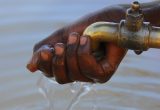Europe’s seas: productive, but not healthy or clean
The European Union’s Blue Growth agenda aims to harness further the potential of Europe’s oceans, seas and coasts for jobs, economic value and sustainability.
A new report published today by the European Environment Agency (EEA) shows that, despite some improvements, the way we use our seas remains unsustainable and threatens not only the productivity of our seas, but also our wellbeing. Human activities and climate change are increasingly putting a number of pressures on Europe’s seas, the cumulative effects of which threaten the functioning and resilience of marine ecosystems.
In line with the development of the European Union’s (EU) Blue Growth objectives, which aspire to greater and sustainable use of the seas’ potential, the EEA’s new ‘State of Europe’s seas’ report examines whether the EU is meeting its policy goals for the quality of the marine environment.
From fisheries to offshore energy production, and protection of marine biodiversity, the EU has a range of policies related to planning and regulating the sustainable use of Europe’s seas. The Marine Strategy Framework Directive, adopted in 2008, aims to ensure coherence between such EU policies and sets three goals for Europe’s seas: to be ‘productive’, ‘healthy’, and ‘clean’. Based on the data available, the EEA finds that although Europe’s seas can be considered productive, they cannot be considered healthy or clean.
The report also looks into describing what ecosystem-based management could mean in the marine context and how to improve our knowledge, as well as considering future challenges in relation to the long-term sustainability of Europe’s seas.
Pressures on the rise
Seas are home to a wide variety of marine life and contain ecosystems essential for life on our planet. They are also an important source of food, raw material, medicine, energy, and are used as global highways for trade.
Only a very limited number of assessments of marine habitats and species indicate favourable conservation status. Current pressures include, among others, physical damage to the seafloor (due to bottom-trawling in particular), introduction of non-indigenous species, nutrient input (mainly from agricultural fertilisers), hazardous substance pollution and marine litter. Climate change induced temperature increases and potential ocean acidification can further weaken the ecological resilience of Europe’s Seas.
A large part of the pressures arises from activities at sea, such as the extraction and production of living resources (fish, shellfish, etc.), transport and energy production, or pollution such as marine litter. Land-based activities — such as the use of agricultural fertilisers and industrial chemicals, and wastewater — also add to the pressures. Human activities are reaching levels that threaten the productivity and resilience of our seas, and our wellbeing. Degrading the oceans’ life-support function could actually mean crossing a critical planetary boundary.
‘We need to respect the ecological boundaries of Europe’s seas if we want to continue enjoying the benefits we receive. This requires aligning our policy ambitions for economic growth with our policy targets of securing healthy, clean and productive seas. Ultimately, this will entail making fundamental changes in the way we meet our societal needs’, said Hans Bruyninckx, EEA Executive Director. ‘Seas are part of our European natural capital and their protection and exploitation require a European approach. In many cases, it also requires a global approach. Our report contributes to the knowledge base needed for relevant policy discussions, currently ongoing at European and global levels,’ added Bruyninckx.
Selection of facts from the report
- For species and habitats assessed from 2007 to 2012 under the EU’s Habitats Directive, 9% of marine habitats and 7% of marine species assessments were in ‘favourable conservation status’, while 66% of habitat and 27% of species assessments were ‘unfavourable’.
- Over 650 marine fish species, over 180 marine bird species, five species of sea turtles and almost 40% of the world’s known marine mammals are found in Europe’s seas.
- Around 320 new non-indigenous species have been observed in Europe’s seas since 2000.
- The knowledge base on marine biodiversity remains very limited, calling for greater cooperation among EU countries and with other countries bordering the regional seas of Europe.
- Climate change is already affecting Europe’s marine ecosystems.
- Hazardous substances are widespread in the marine environment. They can accumulate through the marine food chain and pose health risks to humans.
- Marine litter, mainly in the form of plastic, is also accumulating in Europe’s seas. Most of the litter comes from land-based activities. Micro-plastics can enter the food web.
- Underwater noise from human activities (shipping, renewable energy, oil and gas extraction, etc.) is increasing and can have a wide range of impacts on marine life.
- Signs of improvement are observed in certain pressures, such as fishing and nutrient loading.
- More than half of the commercial fish stocks assessed are not in good environmental status.
- Total catches in all fishing regions have been declining in the past ten years. The EU is increasingly dependent on imports of its most widely consumed species: tuna, cod and salmon.
- The maritime sector is estimated to provide 6.1 million jobs and to generate an economic value of approximately EUR 467 billion.
Report: “State of Europe’s seas” (PDF)








